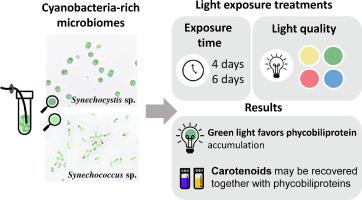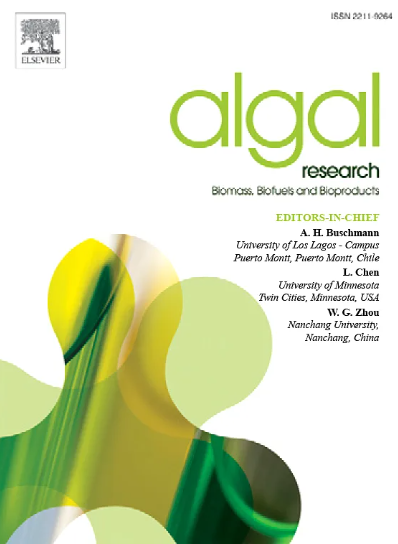Enhancing pigment production with cyanobacteria-rich microbiomes: Effect of light quality and exposure time
IF 4.6
2区 生物学
Q1 BIOTECHNOLOGY & APPLIED MICROBIOLOGY
Algal Research-Biomass Biofuels and Bioproducts
Pub Date : 2024-10-01
DOI:10.1016/j.algal.2024.103726
引用次数: 0
Abstract
Cyanobacteria-rich microbiomes may stand as a cost-effective source of pigments, as they exhibit improved stability in comparison to monocultures and do not require sterile media to grow. However, these bioproduct sources have not been thoroughly optimized for pigment production. The aim of the present study was to evaluate the effects of light quality and exposure time on pigment concentration and population distribution in 6 microbiomes rich in Synechococcus sp. and Synechocystis sp. A multivariable experimental design was implemented for selecting the optimal culture conditions in terms of light quality (white, red, green and blue) and exposure time (4 and 6 days). As a result, differential light quality exposures did not favor the growth of one species over another. Green light had a significantly positive effect on phycobiliprotein content in all microbiomes, with up to a 2.3-fold increase as compared to white light. Indeed, 4 days of exposure induced a change in phycobiliprotein composition in 5 microbiomes. Microbiome M11 was the best phycobiliprotein producer (content up to 145.5 mg gDW−1). Meanwhile, carotenoid contents above 1.8 mg gDW−1 were attained in all the microbiomes under optimized conditions. In conclusion, light quality modulation is a promising approach to stimulate the production of pigments in cyanobacteria-rich microbiomes.

利用富含蓝藻的微生物群提高色素产量:光质和照射时间的影响
富含蓝藻的微生物群可能是一种具有成本效益的色素来源,因为与单一培养物相比,它们表现出更高的稳定性,而且不需要无菌培养基即可生长。然而,这些生物产品来源尚未针对色素生产进行彻底优化。本研究的目的是评估光质和照射时间对 6 个富含 Synechococcus sp.和 Synechocystis sp.结果表明,不同光质的照射并不有利于某一物种的生长。绿光对所有微生物群中的藻胆蛋白含量都有明显的积极影响,与白光相比,最多可增加 2.3 倍。事实上,4 天的照射会导致 5 个微生物群的藻胆蛋白成分发生变化。微生物组群 M11 是最好的藻胆蛋白生产者(含量高达 145.5 毫克 gDW-1)。同时,在优化条件下,所有微生物组的类胡萝卜素含量都超过了 1.8 毫克 gDW-1。总之,在富含蓝藻的微生物组中,光质调节是一种很有前景的刺激色素产生的方法。
本文章由计算机程序翻译,如有差异,请以英文原文为准。
求助全文
约1分钟内获得全文
求助全文
来源期刊

Algal Research-Biomass Biofuels and Bioproducts
BIOTECHNOLOGY & APPLIED MICROBIOLOGY-
CiteScore
9.40
自引率
7.80%
发文量
332
期刊介绍:
Algal Research is an international phycology journal covering all areas of emerging technologies in algae biology, biomass production, cultivation, harvesting, extraction, bioproducts, biorefinery, engineering, and econometrics. Algae is defined to include cyanobacteria, microalgae, and protists and symbionts of interest in biotechnology. The journal publishes original research and reviews for the following scope: algal biology, including but not exclusive to: phylogeny, biodiversity, molecular traits, metabolic regulation, and genetic engineering, algal cultivation, e.g. phototrophic systems, heterotrophic systems, and mixotrophic systems, algal harvesting and extraction systems, biotechnology to convert algal biomass and components into biofuels and bioproducts, e.g., nutraceuticals, pharmaceuticals, animal feed, plastics, etc. algal products and their economic assessment
 求助内容:
求助内容: 应助结果提醒方式:
应助结果提醒方式:


